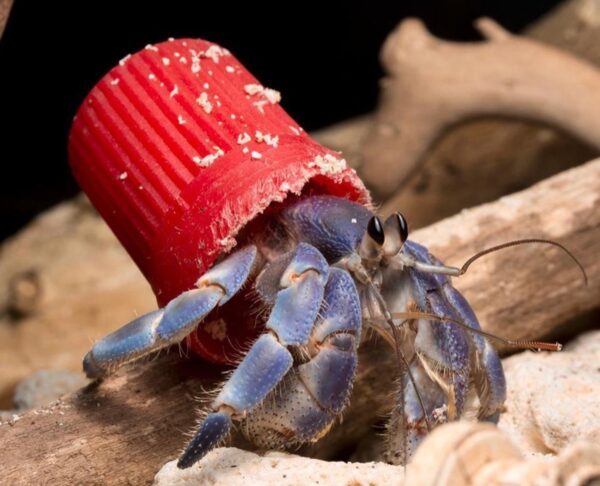Researchers have found that two-thirds of hermit crabs species were pictured in “artificial shells” of plastic waste.
The finding are published in the journal Science of the Total Environment and are based on analysis of photos, taken by wildlife enthusiasts, and published online.
The researchers trawled the internet for pictures of Hermit crabs using the iEcology (internet Ecology) research method, which analyses photographs published on digital platforms, and found 386 instances of the crustaceans using artificial shells, mostly plastic.
The research has been published by Prof. Marta Szulkin and Dr Zuzanna Jagiełło from the Institute of Evolutionary Biology at the Faculty of Biology, the University of Warsaw, and Dr Łukasz Dylewski from Poznań University of Life Sciences.
“Hermit crabs need to protect their soft abdomen. They usually do this by hiding in shells left behind by dead crustaceans. One such hiding place is not enough for a lifetime because of the crab’s development, but also because of intra-species competition,” Prof. Marta Szulkin said.
“In the photographs, we discovered a total of 386 individuals using ‘artificial shells’ – mainly plastic caps, but also made from broken necks of glass bottles or metal ends of light bulbs. According to our calculations, ten out of sixteen species of land hermit crabs in the world use this type of shelter. This unusual behaviour is observed in all tropical regions of the Earth,” Prof. Marta Szulkin explains.
Surfers Against Sewage (SaS) told The Independent that the findings of this new study are “beyond terrifying”.
The findings follow on from previous studies that found around 570,000 crabs were becoming trapped in debris each year on the Henderson and Cocos (Keeling) islands in the Indian Ocean. “The significant quantities of debris on the beaches, and throughout the coastal vegetation, create a significant barrier which strawberry hermit crabs (Coenobita perlatus) encounter during their daily activities,” the paper says. “This is important for countless other islands worldwide where crabs and debris overlap, as crabs play a crucial role in the maintenance of tropical ecosystems”, as Mongabay reported in 2020.
Hermit crabs are sexually attracted to ocean plastic
It is perhaps nowadays no surprise that hermit crabs are found in plastic homes. A recent study attempted to quantify the scale of plastic pollution and estimated that 171 trillion pieces of plastic are floating in the ocean.
However, as well as the vast amount of debris found on beaches and in the ocean, an additive in plastic named Oleamide is already known to be a sex pheromone and stimulant for particular marine species, including shrimp. And a research team at the University of Hull found that when hermit crabs are exposed to the chemical, their respiration rate increases – indicating both excitement and attraction.
Prof. Marta Szulkin said of the recent findings that “These analyses will deepen our understanding of the consequences of plastic pollution in marine ecosystems, as well as the evolution of species in the context of new evolutionary pressures associated with the Anthropocene”.
The full journal paper ‘The plastic homes of hermit crabs in the Anthropocene’ can be read in Science of the Total Environment.

